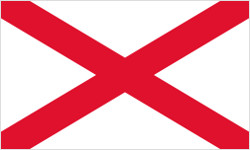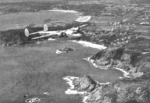
Jersey
| Full Name | 87 Bailiwick of Jersey | |
| Alliance | Allies - Minor Member Nation or Possession | |
| Possessing Power | United Kingdom | |
| Entry into WW2 | 3 Sep 1939 | |
| Population in 1939 | 50,000 | |
| Civilian Deaths in WW2 | 20 |
Contributor: C. Peter Chen
ww2dbaseJersey was a British Crown Dependency located in the Channel Islands just off the Normandie coast of France. Airfields on Jersey were used to launch strikes against German advances in France in 1940, but after the French armistice, the British recognized that the Channel Islands were not defensible, and a belated evacuation hurriedly began, relocating all military personnel and somewhere between 8,000 and 10,000 civilians (most of whom men who had higher military value); most of the population stayed on the island. The Germans arrived on 1 Jul 1940, making Jersey (and neighboring Guernsey) the only British territory to be occupied by German troops during the European War. The German garrison on Jersey would eventually grow to the size of over 11,000. In 1942, German Army engineers, personnel of Organization Todt, and Eastern European slave laborers arrived to fortify the island. Some Jersey civilians were deported to various prisons and concentration camps in continental Europe; at least 20 of them did not return at the end of the war. After the successful Normandie invasion in Jun 1944, the Channel Islands were cut off from Germany, and the winter of 1944 to 1945 posed a serious threat to the welfare of the population. The Red Cross hired the merchant vessel Vega to bring in food and other supplies in Dec 1944, which alleviated the situation; the Red Cross would successfully negotiate with the Germans for Vega to make five more trips to Jersey before the end of the war. Jersey would not return to British control until after the German surrender.
ww2dbaseSource: Wikipedia
Last Major Update: Sep 2013
Photographs
 |
Jersey in World War II Interactive Map
Please consider supporting us on Patreon. Even $1 per month will go a long way! Thank you. Please help us spread the word: Stay updated with WW2DB: |
Visitor Submitted Comments
11 May 2017 08:09:05 AM
I've been told my ancestry traces back to the island and would like to know more. I have some currency and a few pictures but that's it. I was born in 1954 in the US. Thank you.
All visitor submitted comments are opinions of those making the submissions and do not reflect views of WW2DB.

- » Evergreen Museum and Obon Society Working on Returning Undelivered 1945 Mail to Japanese Families (5 Sep 2025)
- » Wreck of Teruzuki Found (27 Jul 2025)
- » USS Orlean's Bow Found (22 Jul 2025)
- » The Emperor of Japan Planned to Honor WW2-era Japanese POWs in Mongolia (4 Jul 2025)
- » US State Lawmaker John Winter Caught Using Racial Slur "Jap" and Apologized (11 Jun 2025)
- » See all news
- » 1,183 biographies
- » 337 events
- » 45,131 timeline entries
- » 1,249 ships
- » 350 aircraft models
- » 207 vehicle models
- » 376 weapon models
- » 123 historical documents
- » 261 facilities
- » 471 book reviews
- » 28,438 photos
- » 365 maps
Winston Churchill
Please consider supporting us on Patreon. Even $1 a month will go a long way. Thank you!
Or, please support us by purchasing some WW2DB merchandise at TeeSpring, Thank you!
19 Oct 2016 01:21:31 AM
Fifteen tanks and 130 men in from 1st Kompanie Panzer Abteilung 213 under the command of Oberleutnant Graf Hoyos were deployed on Jersey in March, 1942, attached to the Schnellabteilung (Mobile Battalion) 319 of the 319th Infantry Division and deployed in the Parish of St. Brelades, Raised, initially, from selected young recruits from 1st Panzer Ersatz Regiment at Erfurt this unit was organised into three platoons of five ex French Army Char B1 bis(f) tanks with the tanks of the 3rd platoon fitted with flamethrowers. Later the unit moved to Tabor Estate and Tabor Lane with the first platoon sent to St. Peter’s barracks. To begin with the tanks were kept in sheds but were subsequently moved to the cover of the pine trees to the east of Tabor Lane where they were ensconced and covered. Many of the younger men would be replaced during the occupation by older soldiers and at the surrender the garrison, less their tanks, was shipped to England. The Tanks would eventually be returned to the French Army.